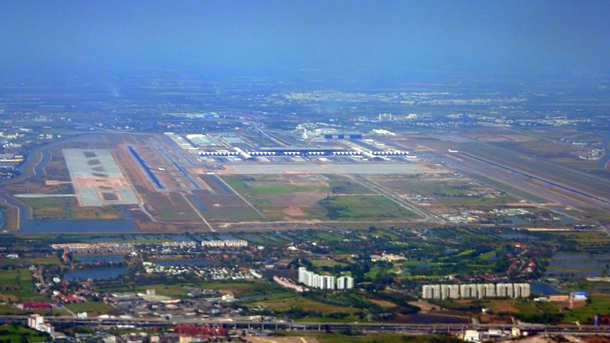Bangkok’s Suvarnabhumi International Airport, which opened only six years ago on what amounted to a swamp, is approaching a crisis stage with overcrowding and increasingly impaired runways, travelers and officials say.
Designed by Helmut Jahn of Murphy/Jahn Architects of Chicago, the airport was in trouble the day it opened, 25 km east of Bangkok, and has rarely been out of trouble. Its construction was widely believed to have been riddled with corruption and mismanagement.
The terminal had to be reconfigured shortly after it opened, with offices having to be closed so the space could be converted into toilets. The facility was designed with a capacity of 45 million passengers when it was opened in September 2006, a year late at that point. It now handles 51 million passengers a year as Thailand’s tourism industry booms.
Although most airports have teething troubles, Suvarnabhumi has become a near legend for frustrated travelers. Some passengers were forced to wait up to four hours for their baggage to appear on the day it was inaugurated.
Cracks began to appear in taxiways and runways almost before it opened and have continued regularly. Aviation and tourism executives have warned repeatedly that the government and the corruption-riddled Airports of Thailand, which administers the facility, must work to maintain safety standards.
The west runway closed for repairs 209 times in 2011 and has been closed 55 times since the beginning of 2012. The eastern one has been closed 66 times, mostly to repair existing cracks. The east runway is now expected to remain closed until Aug. 9 while repairs are made, with aircraft backing up overhead in holding patterns for up to an hour and more as they wait to land. In June, Cathay Pacific warned that there could be delays because of the runway would be closed for months of repairs.
“These are not the isolated sort of corrections expected at the opening of new projects. It is only five-and-a-half years old. These are deeply flawed, fundamental systems deficiencies reflective of a broader mentality,” wrote an engineer on the Thai Visa Forum website.
“The Thai government is trying to remedially correct them, which is always inferior to doing them correctly in the first place…Thailand’s front door and calling card to the world is suffering signs of obsolescence.”
Officials insist that there are no safety concerns, and that the runways are constantly monitored for faults, hence the frequent closures while the problems are taken care of. There are growing fears, however, that piles which were sunk deep into the ground to support the runways on the waterlogged ground were not long enough. Two sinkholes two feet across and two inches deep were discovered in the west runway on July 5, causing apprehension that the soil underneath the runway was subsiding and resulting in a 50-minute closure.
An airport official said the sinkholes were caused by water leaks, however. Flights by Thai International and other airlines were delayed, with four diverted to other airports while workmen struggled to take care of the sinkholes.
The subsoil is of major concern. The average Boeing 747-800, weighing nearly 340 tonnes, slams into a runway at a speed of 188 kilometers per hour. An Airbus A380 double-decker weighs in at 590 tonnes. At full capacity, the airport is designed to handle 76 flight operations per hour. Scores of planes land at Suvarnabhumi every day, with even single-aisle jets weighing 100 to 200 tonnes.
“A runway failure of this type should not be misconstrued as the problem,” wrote an engineer on the Thai Visa Forum website. ”A runway failure such as this is a symptom of a much greater problem, caused by a couple of likely sources. The higher probability is that inferior foundations are the most likely symptom… Less likely is an inferior runway slab itself….The key is the foundation.”
Beyond that, the “Airport of Smiles” appears to be anything but. It has been hit by a multiplicity of problems including power outages, escalators that often break down, inconvenient layout that requires passengers to walk long distances to jetways and many other inconveniences. The terminal’s roof leaks, air conditioning in the terminal is insufficient in Thailand’s baking tropical heat.
On June 22, a power outage took the airport’s control tower, the tallest in the world, out of operation, delaying takeoffs and landings for nearly 50 flights.
“In a country that prides itself on its hospitality, it is an airport that makes you feel unwelcome and unwanted,” one seasoned traveler told Asia Sentinel. “The terminal is miles long and too narrow, making it inconvenient to navigate.
“The toilets are small, dingy and hidden away. There is no free WiFi. The restaurant choice is limited and the eating places are also tucked away at the end of vast corridors devoted to Prada and Hermes. It is in my view the worst new airport in Asia.”
One recent traveler on a flight in from Hong Kong said that as the plane circled for an hour, the pilot became increasingly sarcastic and angry with the situation but reassured passengers there was enough fuel.
“Last time I flew into Bangkok I noticed the storm drain beside the taxiway and apron was cracked, broken and twisted,” a passenger said. “It was falling apart, no different really to the state of the storm drains beside country roads after a few years or the concrete canal banks in Bangkok which have been under constant repair since at least 1995 because the concrete quality is so poor.”
Sisdivachr Cheewarattanaporn, president of the Association of Thai Travel Agents, told The Nation newspaper in Bangkok that the problems at the airport would hurt foreign travelers’ confidence if they are not solved.
“The government should have clear measures to take care of the airport and air traffic in cases where unexpected situations arise,” he said, adding that news of problems at the airport circulates around the world quickly, hurting the country’s image.

















